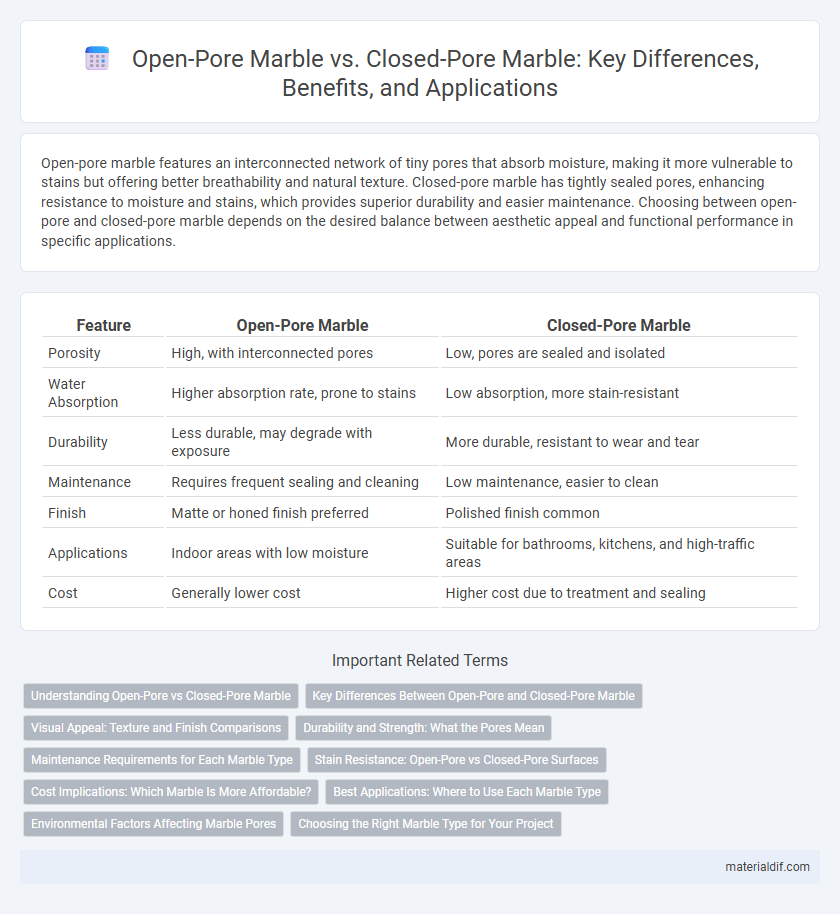Open-pore marble features an interconnected network of tiny pores that absorb moisture, making it more vulnerable to stains but offering better breathability and natural texture. Closed-pore marble has tightly sealed pores, enhancing resistance to moisture and stains, which provides superior durability and easier maintenance. Choosing between open-pore and closed-pore marble depends on the desired balance between aesthetic appeal and functional performance in specific applications.
Table of Comparison
| Feature | Open-Pore Marble | Closed-Pore Marble |
|---|---|---|
| Porosity | High, with interconnected pores | Low, pores are sealed and isolated |
| Water Absorption | Higher absorption rate, prone to stains | Low absorption, more stain-resistant |
| Durability | Less durable, may degrade with exposure | More durable, resistant to wear and tear |
| Maintenance | Requires frequent sealing and cleaning | Low maintenance, easier to clean |
| Finish | Matte or honed finish preferred | Polished finish common |
| Applications | Indoor areas with low moisture | Suitable for bathrooms, kitchens, and high-traffic areas |
| Cost | Generally lower cost | Higher cost due to treatment and sealing |
Understanding Open-Pore vs Closed-Pore Marble
Open-pore marble features a porous surface that absorbs water and stains more readily, making it less suitable for high-moisture environments without proper sealing. Closed-pore marble has a denser, less absorbent surface that resists moisture and staining, providing enhanced durability and easier maintenance. Choosing between open-pore and closed-pore marble depends on the intended use, exposure to elements, and desired longevity of the marble surface.
Key Differences Between Open-Pore and Closed-Pore Marble
Open-pore marble features interconnected pores that allow higher water absorption, making it more prone to staining and weathering, while closed-pore marble has tightly packed grains that reduce porosity and improve resistance to moisture and dirt penetration. The physical structure of open-pore marble results in a rougher texture and increased vulnerability to chemical damage, whereas closed-pore marble boasts a smoother surface and enhanced durability. These intrinsic differences influence maintenance requirements, with open-pore marble demanding more frequent sealing compared to the lower upkeep needs of closed-pore varieties.
Visual Appeal: Texture and Finish Comparisons
Open-pore marble features a more pronounced texture with visible natural pits and veins, creating a rustic and authentic aesthetic that enhances depth and character. Closed-pore marble offers a smoother, polished finish with minimal surface imperfections, resulting in a sleek and refined look ideal for modern and elegant interiors. The choice between open-pore and closed-pore marble significantly influences the tactile sensation and visual sophistication of the space.
Durability and Strength: What the Pores Mean
Open-pore marble features interconnected pores that can absorb moisture and stains, potentially compromising its durability and strength over time. Closed-pore marble has tightly sealed pores that resist water infiltration, enhancing its structural integrity and making it more durable in high-traffic or wet environments. The density and pore structure directly affect the marble's resistance to wear, making closed-pore varieties preferable for long-lasting applications.
Maintenance Requirements for Each Marble Type
Open-pore marble requires more frequent sealing and careful cleaning to prevent staining and moisture penetration due to its porous surface. Closed-pore marble has a denser structure that resists water absorption, making it easier to maintain with less frequent sealing and simpler cleaning routines. Regular assessment of surface condition is essential for both types to preserve their appearance and durability over time.
Stain Resistance: Open-Pore vs Closed-Pore Surfaces
Open-pore marble features a porous surface that readily absorbs liquids, making it more susceptible to stains compared to closed-pore marble, which has a sealed, non-porous surface that prevents liquid penetration. Closed-pore marble offers superior stain resistance due to its density and protective finish, requiring less frequent sealing and maintenance. For spaces prone to spills or high moisture exposure, closed-pore marble is the preferred choice to maintain aesthetic integrity over time.
Cost Implications: Which Marble Is More Affordable?
Open-pore marble generally incurs higher maintenance costs due to its porous surface that absorbs stains and requires frequent sealing, raising long-term expenses. Closed-pore marble offers greater resistance to moisture and staining, reducing the need for regular upkeep and making it more cost-effective over time. The initial purchase price of closed-pore marble is often higher, but the lower maintenance costs make it a more affordable option in the long run.
Best Applications: Where to Use Each Marble Type
Open-pore marble, characterized by its porous surface, is best suited for indoor applications such as bathroom walls and decorative elements where moisture absorption is minimal and breathability is advantageous. Closed-pore marble, with its dense, non-porous structure, excels in high-traffic areas like kitchen countertops and flooring, offering superior resistance to stains, spills, and wear. Selecting the appropriate marble type ensures durability and maintenance efficiency, optimizing performance in residential and commercial environments.
Environmental Factors Affecting Marble Pores
Open-pore marble exhibits higher permeability due to its interconnected pore structure, making it more susceptible to environmental factors such as moisture absorption, freeze-thaw cycles, and pollution, which can accelerate weathering and surface degradation. Closed-pore marble contains isolated pores that reduce water infiltration and limit chemical reactions with atmospheric pollutants, enhancing durability in harsh climates. Understanding the pore structure's influence on moisture dynamics and pollutant interaction is crucial for selecting marble suited to specific environmental conditions and ensuring long-term preservation.
Choosing the Right Marble Type for Your Project
Open-pore marble offers enhanced breathability and natural texture, making it ideal for spaces requiring moisture regulation and a more rustic aesthetic. Closed-pore marble, characterized by its dense surface, provides superior stain resistance and durability, suitable for high-traffic areas or environments exposed to liquids. Selecting between open-pore and closed-pore marble depends on project needs such as maintenance ease, environmental exposure, and desired finish quality.
Open-pore marble vs Closed-pore marble Infographic

 materialdif.com
materialdif.com